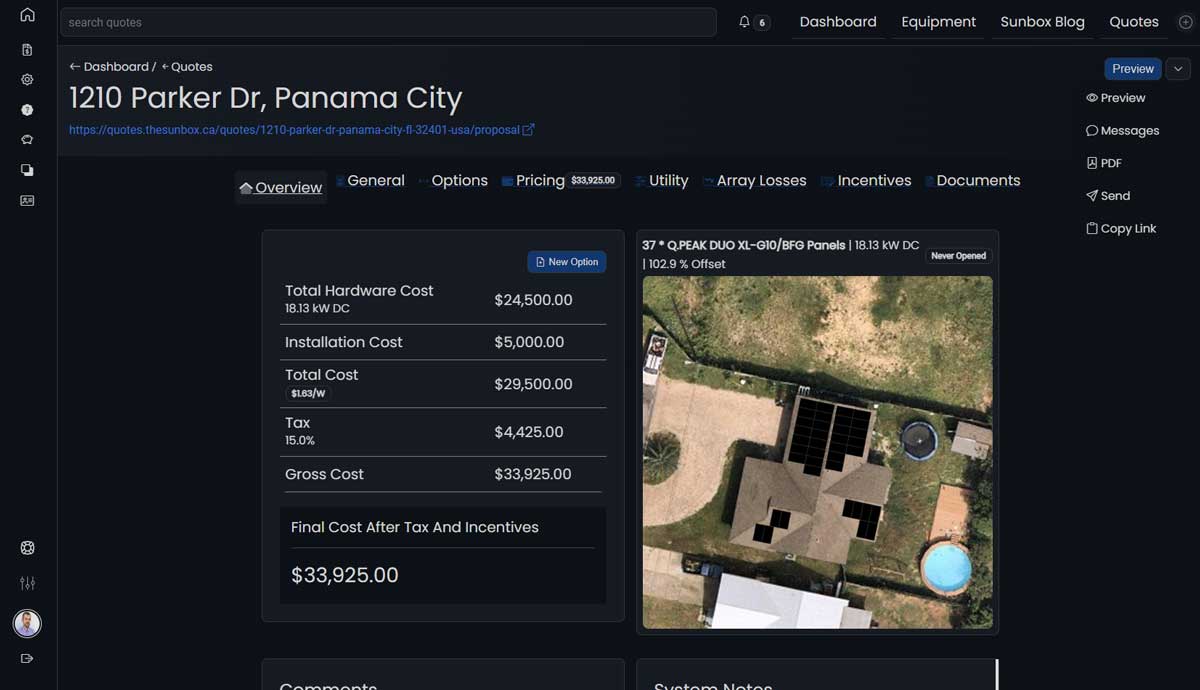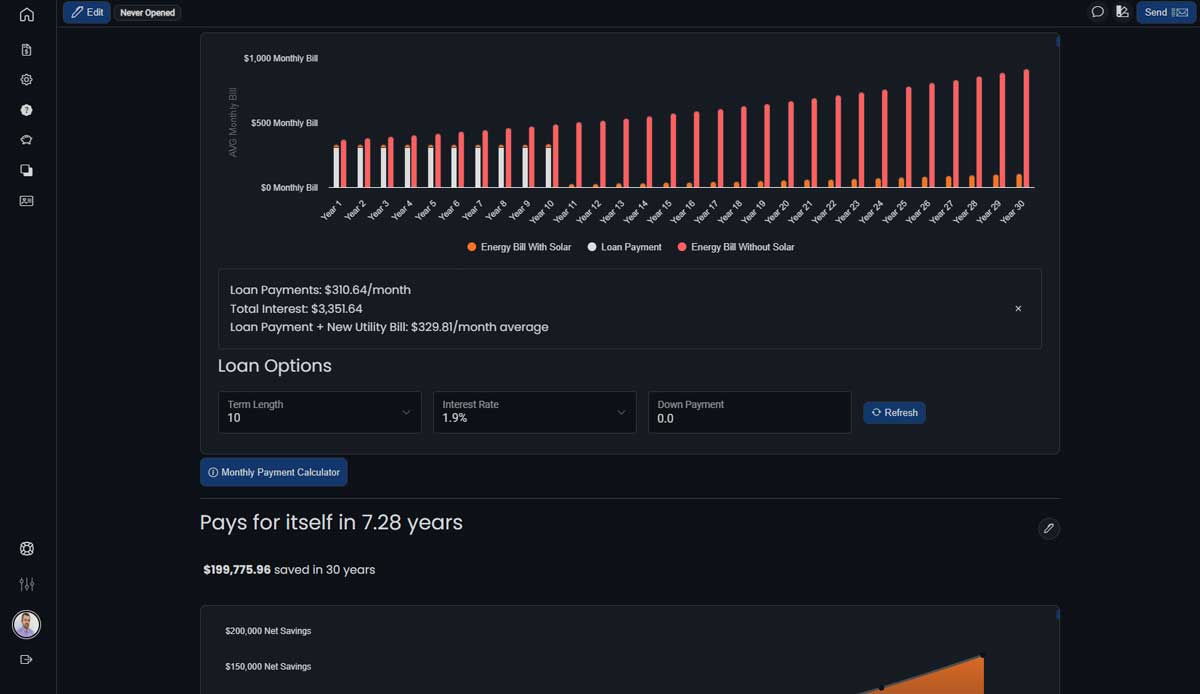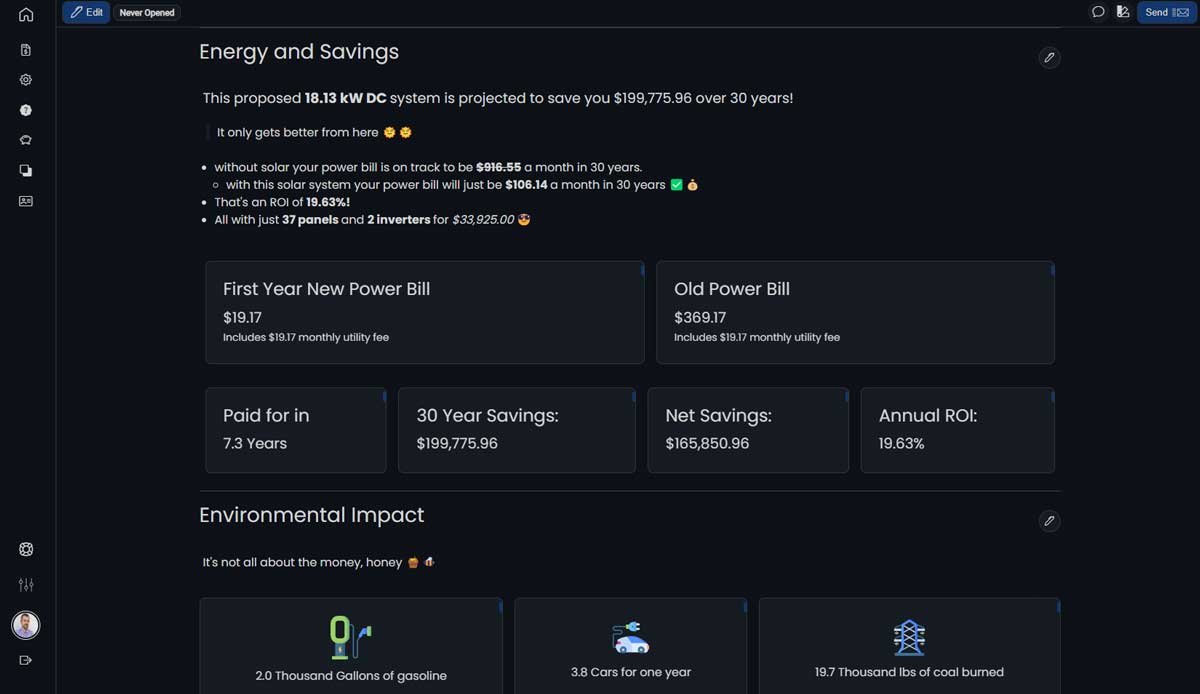- Canada's solar industry, thriving under robust growth, still struggles with a glaring software gap due to tools designed with a U.S. focus.
- Powerlily, a new platform developed by Canadian entrepreneur Tom Rendle, promises to tailor the sales software to meet the unique demands of Canadian installers, particularly in rural areas.
- This shift towards localized solutions could bridge the existing software gap, changing proposal processes and enhancing operational efficiency across the industry.
The solar industry in Canada has witnessed remarkable growth in recent years, driven by the increasing demand for renewable energy and supportive government policies. Solar power has become a leading solution in this sector, promising a sustainable future for energy production in Canada.
However, despite this progress, solar installers in Canada face a significant challenge: the lack of sales software tailored to their specific needs. Many existing platforms are designed with features catered solely to the US market, leaving Canadian installers paying for unsuitable or incomplete tools.
Software options available favor the U.S. market
This clear favoritism towards the U.S. market has become increasingly evident. Features crucial for efficient operations are unavailable or dropped for Canadian users without corresponding pricing adjustments. For example, integrated loan companies, a common feature in US-focused platforms, are inaccessible in Canada due to the absence of corresponding service providers. This disparity disadvantages solar installers in Canada, forcing them to work with inadequate tools and hindering their ability to compete effectively.
Moreover, the proposal processes provided by these U.S.-centric platforms are cumbersome and not optimized for the Canadian market. Inadequate imaging technologies and a lack of integration with Canadian financial institutions further complicate the situation, making it challenging for installers to streamline their operations and deliver optimal service to their clients.
The existing software gap
The gap in software solutions tailored to the Canadian market is not just a minor inconvenience but a significant barrier to the solar industry’s growth and efficiency. There is a pressing need for software that understands and addresses the unique challenges solar installers face in Canada, from regulatory differences to financial integration and localized imaging requirements.
To ensure the continued growth and success of the solar industry in Canada, it is important to develop and adopt sales software specifically designed to meet the needs of this market. Such tailored solutions would empower Canadian solar installers to operate more efficiently, provide better service to their clients, and ultimately contribute to a more sustainable future for all.
New software by Canadian entrepreneur promises to bridge the gap
One Canadian market entrepreneur looking to tackle this issue is Tom Rendle, Watts Up Solar LTD Director.
I recently spoke with Tom after a press release published on pvbuzz | media announcing the launch of Powerlily, a platform Tom says is designed to simplify the solar proposal and quoting process.
Tom points out, “We’ve seen these other software platforms become increasingly bloated with features many Canadians don’t even have access to. This disparity led us to develop Powerlily,” Tom continues, “a software solution focused on addressing the specific needs of Canadian solar companies, particularly in rural areas.”
Sofia: What is Powerlily?
Tom: We think Powerlily is the mission-critical software solar companies want to use. Our core team has delivered somewhere in the ballpark of 10,000 solar proposals over the years, so we really wanted to make something that just felt fun, easy, and fast.

Screenshot of the user interface for the Powerlily solar proposal software tool. On the left side of the screen, there is a detailed breakdown of costs for a solar project. This includes various costs such as hardware, installation, and taxes, leading to a total and final cost after tax and incentives. On the right, there’s an aerial view of a property overlaid with solar panel placements, indicating how the solar installation would look on the actual property. The interface includes tabs like “Overview,” “General,” “Options,” “Pricing,” “Array Losses,” “Incentives,” and “Documents,” suggesting comprehensive functionality for preparing and managing solar proposals. (Provided by Powerlily)
Sofia: What makes customizable proposals valuable to solar installers?
Tom: A company’s proposal is a significant component of its marketing and brand awareness strategy. Potential customers widely circulate and carefully study it, making it a critical opportunity to convey your message effectively.
Customers often focus on the pricing details. Our experience shows that transparency builds trust, and when companies are open about their equipment and pricing, they become more competitive.
With our software, we aimed to streamline this process by integrating all relevant information from your sales workflow into a single platform. Our solution allows you to maintain a custom domain, offers high “configurability,” and emphasizes agility and efficiency.
Sofia: Why was efficiency one of the key challenges you hoped to tackle?
Tom: We’ve talked to many customers who will write off a company if they can’t get a proposal from them in under a week or even, in some cases, a couple of days. That’s why we offer a streamlined solution to help installers generate proposals quickly without compromising accuracy.

Screenshot of the user interface for the Powerlily’s solar proposal software tool featuring a financial dashboard from a solar proposal software, focused on loan and payment analysis for a solar energy project. It displays a bar graph comparing monthly energy bills with and without solar installation over 30 years, highlighted in red and orange respectively, with an overlay of loan payments shown in grey. The graph illustrates how the energy bill decreases significantly with solar power, despite the loan payment. Additionally, there is an interactive section labeled “Loan Options” where users can adjust the term length and interest rate, with a “Monthly Payment Calculator” button for recalculations. (Provided by Powerlily)
Sofia: How does Powerlily help solar installers in Canada?
Tom: We know good aerial imagery is a big deal in Canada, particularly in rural areas. I mean, it is a big deal everywhere when you do this type of work, but outside of Canada, your standard providers like Google Maps are a lot more up to date and clear. We regularly use imagery from all of our providers. We wouldn’t be able to effectively quote a significant percentage of our clients if we didn’t have access to Pictometry and Nearmap through our platform.
Sofia: So you’ve been using this for a while; how has it been going?
Tom: Compared to other tools available on the market, Powerlily feels very fast. It is integrated so well into our workflow that we never need to type out a customer’s details or copy and paste information. The software automatically calculates our pricing and incentives, so quotes are ready to send after the design is finished. We took a process that took an average of 20 minutes and brought it down to under 5 minutes without sacrificing accuracy. The best part is we are seeing around a 30% close rate on our proposals, a metric we couldn’t easily track with our previous software provider.
Sofia: Can you tell me more about Powerlily’s features, what’s different about it?
Tom: One of the biggest things to mention is the custom domain support. We hated sending our clients to a third-party website to view proposals. The links often confuse customers, especially when they go to the same website to view quotes from multiple solar providers.
Powerlily puts your team’s quotes, equipment, spec sheets, and knowledge base in one place on your domain—completely white-labelled and configurable. Your customer receives a quote from you, not a third-party platform, which enhances your brand presence and credibility.

Screenshot of the user interface for the Powerlily’s solar proposal software tool showcasing an analytical summary from a solar energy software tool focused on energy and savings, along with environmental impact metrics. The main panel titled “Energy and Savings” highlights the benefits of an 18.13 kW DC solar system, projecting a total savings of $199,775.96 over 30 years. It emphasizes a significant reduction in monthly power bills—from $369.17 to $108.14—and details an impressive return on investment (ROI) of 19.63%. The panel displays this data in a clear, user-friendly format, comparing the first-year new power bill to the old power bill and outlining the payback period as 7.3 years. (Provided by Powerlily)
Sofia: Let’s talk pricing because it all comes to affordability. What would users pay for access to the platform?
Tom: Yes, the brass tacks. We decided to avoid the per-seat subscription model prevalent in the industry and offer what we consider to be a fair pricing model instead. We offer one monthly cost for unlimited users and unlimited quotes. There is a light version with just Google Maps and Bing imagery and a full version that includes custom domain support, Pictometry, and Nearmap imagery. Both tiers are orders of magnitude less expensive than other platforms.
Sofia: Is Powerlily available to solar installers?
Tom: We’re ready to launch and have many plans for future updates. In our own system, we have integrated many other components that will all be available in Powerlily over time, such as full CRM and project management, health and safety compliant employee forms our crew members sign for each project, a system monitoring dashboard, project portfolio, invoicing and a client portal. It’s pretty much the whole shebang.
Impact of software focused on the Canadian market
Introducing such a platform represents a significant step forward for the solar industry in Canada. It offers a practical response to the inadequacies of US-centric software, potentially levelling the playing field for installers. As this software becomes available, it may alleviate many of the frustrations currently experienced by the industry, fostering a more conducive environment for the growth and adoption of solar energy across Canada.
Furthermore, having localized imaging and proposal tools can enhance the accuracy and appeal of solar project proposals. High-quality, region-specific imaging can provide potential customers with a clear and realistic view of how solar installations will look and perform on their properties. This transparency can build trust and confidence, leading to higher conversion rates for solar projects.
Another critical advantage is the platform’s ability to streamline the proposal process. The software can save installers valuable time and resources by automating and optimizing various aspects of proposal generation. This efficiency allows them to handle more projects simultaneously, increasing their capacity and potential revenue.
Bridging the software gap
Overall, developing and implementing this specialized software helps bridge the software gap in providing swift solar proposals and quoting in Canada. By embracing such solutions, the industry can unlock heightened efficiency and gain time to focus on what matters most– delivering superior service to clients.
Bridging the gap would also help accelerate Canada’s transition towards a sustainable energy future. It’s a call to action for software developers and industry stakeholders alike to continue making more features available in Canada and propelling our solar industry toward greater success and impact.
















Comments